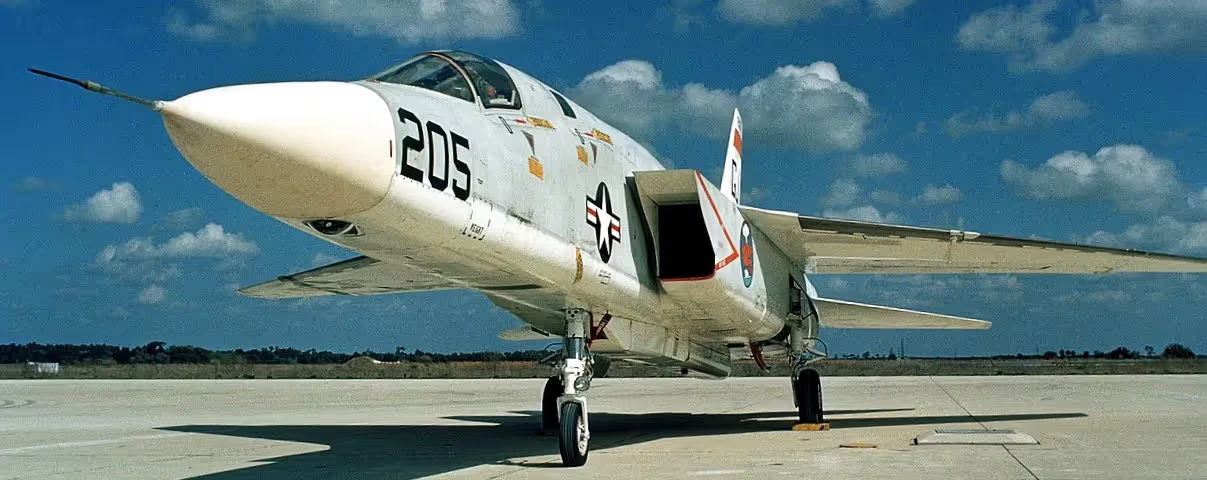Warplanes of the USA: North American A-5 Vigilante
North American A-5 Vigilante
.avif)
(USN Photo)
North American RA-5C Vigilante (BuNo. 156640) of Reconnaissance Heavy Attack Squadron 3 (RVAH-3) "Sea Dragons" in flight on 1 June 1976.
The North American A-5 Vigilante is an American carrier-based supersonic bomber designed and built by North American Aviation (NAA) for the United States Navy. Before the 1962 unification of Navy and Air Force designations, it was designated A3J. Development of the A-5 began in 1954 as a private venture by NAA, who sought to produce a capable supersonic long-distance bomber as a successor to the abortive North American XA2J Super Savage. It was a large and complex aircraft that incorporated several innovative features, such as being the first bomber to feature a digital computer, while its ability to attain speeds of up to Mach 2 while carrying a nuclear strike payload was also relatively ambitious for the era.
The US Navy saw the value of such a bomber, leading to a contract for its full development and production being issued to the firm on 29 August 1956. The type performed its first flight just over two years later, on 31 August 1958.The Vigilante was introduced by the US Navy during June 1961; it succeeded the Douglas A-3 Skywarrior as the Navy's primary nuclear strike aircraft, but its service in this capacity was relatively brief due to the de-emphasising of manned bombers in American nuclear strategy. A far larger quantity of the RA-5C tactical strike reconnaissance variant were also procured by the service, which saw extensive service during the Vietnam War.
The Vigilante established several world records in both long-distance speed and altitude categories. During the mid-1970s, the withdrawal of the type commenced after a relatively short service life, largely due to the aircraft being expensive and complex to operate, as well being a victim of post-Vietnam military cutbacks. (Wikipedia)
_in_1969.avif)
(USN Photo)
North American RA-5C Vigilante (BuNo 146696) from Reconnaissance Heavy Attack Squadron 1 (RVAH-1) "Smokin' Tigers" lands on the aircraft carrier USS Saratoga (CVA-60) in May 1969. RVAH-1 was assigned to Attack Carrier Air Wing 3 (CVW-3) aboard the Saratoga during operations in the Western Atlantic between March and June 1969.

(USN Photo)
North American A3J-1 Vigilante nuclear bombers from heavy attack squadron seven VAH-7 Peacemakers of the Fleet on flight deck of the aircraft carrier USS Enterprise (CVAN-65). VAH-7 was assigned to Carrier Air Group Six (CVG-6) aboard the Enterprise in 1962 for a deployment to the Mediterranean Sea and during the Cuban Missile Crisis. In the foreground is the tail of a McDonnell F4H-1 Phantom II of fighter squadron VF-102 Diamondbacks.
_1962.avif)
(USN Photo)
Vought F8U-1 Crusader from Fighter Squadron VF-62 Boomerangs and a North American A3J-1 Vigilante of Heavy Attack Squadron VAH-7 Peacemakers of the Fleet launch from the aircraft carrier USS Enterprise (CVAN-65) in early 1962. The Big E, with Carrier Air Group 1 (CVG-1) embarked, was on her shakedown cruise in the Atlantic Ocean from 5 February to 5 April 1962.

(USN Photo)
RA-5C Vigilante, (BuNo. 156608), from Reconnaissance Attack Squadron 7 (RVAH-7) during what may have been its final flight in 1979. This aircraft is now on permanent display at Naval Support Activity Mid-South (formerly Naval Air Station Memphis), Tennessee.

(NASA Dryden Flight Research Center Photo)
A North American Aviation A3J-1 Vigilante (Navy serial number 147858/NASA tail number 858) arrived from the Naval Air Test Center, Patuxent River (Maryland, USA), on 19 December 1962 at the NASA Flight Research Center (now Armstrong Flight Research Center, Edwards, California). The Center flew the A3J-1 in a year-long series of flights in support of the U.S. supersonic transport program. The Center flew the aircraft to determine the let-down and approach conditions of a supersonic transport flying into a dense air traffic network. These flights followed two flight plans that were based upon earlier NASA Flight Research Center studies, one for a variable-sweep wing configuration and the other for a delta-wing configuration. NASA Flight Research Center test pilot William H. Dana made approximately 21 flights along federal airways that entered Los Angeles. With the completion of the research flights, the Center sent the A3J-1 back to the Navy on 20 December 1963.

(NMNA Photo)
North American A3J-2 Vigilante with weapons array at North American Aviation at Columbus, Ohio (USA). The first YA-5C (BuNo 149300) flew on 29 April 1962, however the A-5B/A-5C bomber variant was never produced. Eventually, all A-5B/YA-5Cs built and 42 of 57 A-5As were converted to RA-5C reconnaissance aircraft.

(NMNA Photo)
North American YA-5C Vigilante (BuNo. 149305) of Heavy Attack Squadron 3 (VAH-3), USN, on display at Naval Air Station South Weymouth, Massachusetts, ca. 1963.
_1962.avif)
(USN Photo)
The crew of a U.S. Navy North American A3J-1 Vigilante bomber from heavy attack squadron VAH-7 Peacemakers of the Fleet, Carrier Air Group 6 (CVG-6), in front of their aircraft aboard the aircraft carrier USS Enterprise (CVAN-65) in 1962.

(NMNA Photo)
McDonnell Douglas F-4J Phantom II aircraft (BuNo. 155799) from fighter squadron VF-92 Silver Kings in flight with a North American RA-5C Vigilante (BuNo. 156614) from heavy reconnaissance squadron RVAH-11 Red Checkertails over Oahu, Hawaii, in 1971. Both aircraft were working up before a combat deployment to Vietnam as part of Carrier Air Wing 9 (CVW-9) aboard the aircraft carrier USS Constellation (CVA-64) from 1 October 1971 to 1 July 1972.

(USN Photo)
North American RA-5C Vigilante of Reconnaissance Heavy Attack Squadron 3 (RVAH-3) "Sea Dragons" is parked on the flight line at Naval Air Station Sanford, Florida (USA), on 27 March 1968.

(USN Photo)
At least thirteen retired U.S. Navy North American RA-5C Vigilante at the Military Aircraft Storage and Disposal Center (MASDC) at Davis-Monthan Air Force Base, Tucson, Arizona (USA), in the 1970s. The RA-5Cs were of the first production batch delivered in the early 1960s. The first aircraft in line, BuNo 150829, was retired as 4A0013 on 27 April 1971.
Surviving Vigilantes on display in the USA

(Aerial Visuals Photo)
North American A-5A Vigilante (BuNo. 146697). Naval Air Station Patuxent River, Lexington Park, Maryland. It is the oldest Vigilante on display and the only one still in its original A3J/A-5A nuclear attack bomber configuration.

(kitmasterbloke Photo)
_(5732728654).avif)
(Frank Kovalchek Photo)



(Author Photos)
North American RA-5C Vigilante (BuNo. 149289). Pima Air & Space Museum in Tucson, Arizona. It was transferred from long-term storage at nearby Davis-Monthan Air Force Base and it carries the markings of RVAH-3.

(Kristian Jones Photo)
North American RA-5C Vigilante (BuNo. 151629). Pueblo Weisbrod Aircraft Museum (formerly the Fred E. Weisbrod Museum/Internationa B-24 Museum) in Pueblo, Colorado. It has been restored and currently displays the markings of RVAH-7 while assigned to Carrier Air Wing 9 aboard the USS Enterprise.

(Thomas R Machnitzki Photo)
North American RA-5C Vigilante (BuNo. 156608). Naval Support Activity Mid-South, formerly Naval Air Station Memphis, Tennessee. It was the last operational RA-5C aircraft and it carries the markings of its last squadron, RVAH-7, during its final deployment with Carrier Air Wing 2 aboard USS Ranger in 1979.
North American RA-5C Vigilante (BuNo. 156612). Naval Air Station Key West, Florida. "Gate guard" aircraft located just inside the main gate. It carries the markings of RVAH-3.
.avif)
(Alan Wilson Photo)



(kitmasterbloke Photos)
North American RA-5C Vigilante (BuNo. 156615). Castle Air Museum at the former Castle Air Force Base, California in 2012. This aircraft was formerly located on the Naval Air Weapons Station China Lake Range. This particular RA-5C was the last Vigilante to land aboard the USS Ranger (CV-61) while assigned to RVAH-7 in August 1979 during the last Vigilante overseas carrier deployment.
.avif)
.avif)
(Doug Kerr Photos)
North American RA-5C Vigilante (BuNo. 156621). New York State Aerosciences Museum (ESAM) in Glenville, New York. It was initially on display at the former US Naval Photographic School at Naval Air Station Pensacola. In 1986, it was shipped up the East Coast by barge and placed on display aboard the USS Intrepid Museum in New York City. In 2005, this RA-5C was acquired by ESAM. The aircraft suffered minor damage to its fuselage aft of the wing root while being moved from the aircraft carrier Intrepid to a barge while supported by slings. It is undergoing restoration for display. It carries the markings of the RA-5C Fleet Replacement Squadron (FRS), RVAH-3.

(Tomas Del Coro Photo)
North American RA-5C Vigilante (BuNo. 156624). National Naval Aviation Museum at Naval Air Station Pensacola. It is displayed in the markings of RVAH-6 per that squadron's final cruise with Carrier Air Wing 8 aboard USS Nimitz in 1978.
.avif)
.avif)
(Valder137 Photos)
North American RA-5C Vigilante (BuNo. 156632). Orlando Sanford International Airport (formerly Naval Air Station Sanford) in Sanford, Florida. It was placed there on 30 May 2003 as a memorial to A-5A and RA-5C aircrewmen and support personnel who served at NAS Sanford. On loan from the National Museum of Naval Aviation, the aircraft was transferred from the Naval Air Systems Command (NAVAIR) Weapons Division at Naval Air Weapons Station China Lake, California and is marked as an RVAH-3 aircraft.

(Robert Nichols Photo)

(D.R. de Pruis Photo)
North American RA-5C Vigilante (BuNo. 156638). Naval Air Station Fallon, Nevada. It was transferred from Naval Air Weapons Station China Lake, California and was previously marked as an RVAH-6 aircraft in a Vietnam-era jungle camouflage paint scheme, as an RVAH-12 aircraft in traditional Cold War gray/white paint scheme, and currently as an RVAH-7 aircraft in traditional gray/white paint scheme.

(Greg Goebel Photo)

(Jeff Kubina Photo)

(Author Photo)
North American RA-5C Vigilante (BuNo. 156641). USS Midway Museum in San Diego, California. It carries the markings of RVAH-12 and RVAH-7 Both squadrons represented on the tail of the aircraft.

(Spetsnazdan Photo)


(Acroterion Photos)
North American RA-5C Vigilante (BuNo. 156643). Patuxent River Naval Air Museum, at Naval Air Station Patuxent River, Maryland. It was transferred from Naval Air Station Key West and is displayed as a test aircraft operated by the Patuxent River Flight Test Division in the 1970s. It was the last RA-5C built.
North American RA-5C Vigilante preserved overseas

(Judgeflor Photo)
BuNo 147858 – It was transferred from long-term storage at nearby Naval Air Station Cubi Point. On Public Display at a Public Park in Olongapo City in Zambales, in the Philippines.





